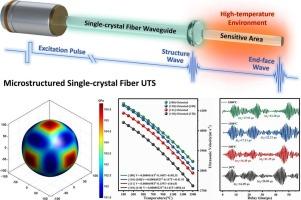基于声学各向异性工程的高灵敏度准分布超声测温微结构Y3Al5O12单晶光纤
IF 7.9
2区 材料科学
Q1 MATERIALS SCIENCE, MULTIDISCIPLINARY
引用次数: 0
摘要
航空航天、核能和先进制造业的快速发展,对极端环境温度传感的需求日益增长。超声温度传感器由于其工作温度接近波导材料的熔点,在高温传感领域得到了广泛的应用。本文采用激光加热基底生长(LHPG)方法成功制备了具有空间分布声反射微结构的YAG单晶光纤(SCF),并将其用作声波导。其中,[110]取向的YAG SCF在s波极化方向为[11¯0]时表现出更高的单位灵敏度,这主要归因于其较低的声速和更大的速度随温度的变化。基于[110]取向YAG SCF的2个离散传感单元,实现了30 ~ 1800℃范围内的准分布式超声温度传感,最大单元灵敏度为47.18 ns·℃-1·m-1, 1800℃时的最佳温度分辨率为5.04℃。优越的声波导特性、广泛的工作温度范围以及与温度相关的传感器性能表明[110]定向微结构YAG SCF是恶劣环境下分布式高温传感的理想候选器件。本文章由计算机程序翻译,如有差异,请以英文原文为准。

Microstructured Y3Al5O12 single-crystal fibers for high-sensitivity quasi-distributed ultrasonic thermometry based on acoustic anisotropy engineering
The rapid development of aerospace, nuclear energy, and advanced manufacturing has created a growing demand for temperature sensing in extreme environments. Ultrasonic temperature sensors (UTS) are widely used in high-temperature sensing due to their extreme operating temperature close to the melting point of the waveguide materials. In this work, YAG single-crystal fibers (SCF) with spatially distributed acoustic reflection microstructures have been successfully fabricated via the laser-heated pedestal growth (LHPG) method and employed as acoustic waveguides. Herein, anisotropic acoustic waveguide behaviors were revealed in YAG SCF, where the [110]-oriented YAG SCF demonstrates enhanced unit sensitivity with the S-wave polarization direction of [], primarily attributed to the lower acoustic velocity and the more substantial velocity variations with temperature. Furthermore, quasi-distributed ultrasonic temperature sensing in the range of 30-1800℃ has been achieved based on the [110]-oriented YAG SCF with two discrete sensing units, reaching the maximum unit sensitivities of 47.18 ns·℃-1·m-1 and an optimal temperature resolution of 5.04℃ at 1800℃. Superior acoustic waveguide characteristics, a wide working temperature range, and the positive temperature-dependent sensor performance suggest that the [110]-oriented microstructured YAG SCF is an ideal candidate for distributed high-temperature sensing in harsh environments.
求助全文
通过发布文献求助,成功后即可免费获取论文全文。
去求助
来源期刊

Materials & Design
Engineering-Mechanical Engineering
CiteScore
14.30
自引率
7.10%
发文量
1028
审稿时长
85 days
期刊介绍:
Materials and Design is a multi-disciplinary journal that publishes original research reports, review articles, and express communications. The journal focuses on studying the structure and properties of inorganic and organic materials, advancements in synthesis, processing, characterization, and testing, the design of materials and engineering systems, and their applications in technology. It aims to bring together various aspects of materials science, engineering, physics, and chemistry.
The journal explores themes ranging from materials to design and aims to reveal the connections between natural and artificial materials, as well as experiment and modeling. Manuscripts submitted to Materials and Design should contain elements of discovery and surprise, as they often contribute new insights into the architecture and function of matter.
 求助内容:
求助内容: 应助结果提醒方式:
应助结果提醒方式:


